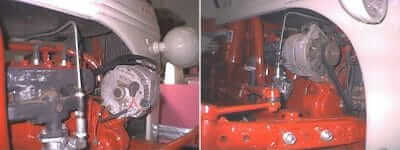12-Volt Conversion
Looking For Something?
Question:
“How do I convert my 8N to a 12 volt system?”
Answer:
You would need to get a Delco alternator (internal regular type is the easiest), fabricate the brackets to mount it, get a wider pulley for the front of it, run new wire to hook it up, and get a resistor to drop the voltage to the coil. If you’re not familiar with electrical systems, I would recommend buying the kit that is available for this. It would be a little more expensive, but you get all the parts you need and instructions, too. Kits are available from several sources.
On the web, you can find them at Just8Ns . If you’re a determined do-it-yourselfer, first pick up an alternator. Tell the parts counter guy it’s for a ’76 Chevy. GM used this same alternator on about all it’s vehicles from the early ’70’s through the mid ’80s. Fabricate some brackets to mount it. If you have the tools and ability to make brackets, you won’t need to ask how. If you have to buy the brackets pre-made, you are probably not going to save any money and might as well buy the kit to start with.

Typical installation on a front distributor 8N

Typical installation on a side distributor 8N
The next step is wiring. Looking at the back of the alternator, you’ll see a threaded post connector sticking out. Along the top edge, just to the right of the post, you’ll see two spade connectors pointing up. These are numbered “1” and “2”, left to right. It’s best to have the correct double connector pigtail to plug on to these spade connectors. You can snip one off at a salvage yard, or pick up a brand new one at the auto parts store for a couple of bucks.
They have them on those red bubble pack cards with the HELP name. There will be a smaller black or brown wire on the pigtail that goes to connector “1” and a larger red wire that goes to connector “2”. The larger red wire goes over to the left and connects to the rear post connector. Get a length of heavy red wire (12 gauge minimum) and attach it to the rear post connector also.
Run this wire up to the junction block on the dash and connect it with the “hot” wire coming from the battery. Get a length of smaller black wire (14 or 16 gauge) and connect it to the small black or brown wire on the pigtail. Run it up to the dash. This is the exciter wire for the regulator inside the alternator. This will connect to the side of the ignition switch that is only “hot” when the switch is on, but it must connect through a resistor (side marker lamp) or a diode. If you leave this out, you’ll turn off the ignition switch and your tractor will keep running. I have used diodes, and they work great for me. Side marker lamps sometimes work and sometimes don’t.
Run up to Radio Shack and get a diode that’s reasonably heavy, at least one amp or more should do it. Wire it inline so that the arrow or ring painted around the end points to the alternator. There is one other option if you don’t want to mess with a marker light or diode and it’s the one I prefer.
Get a universal ignition switch at the auto parts store that has an ACC (accessory) position as well as an ON position. Hook the exciter wire to the ACC terminal instead of the ON terminal and you’re in business. No diodes or lights are necessary. Install the 12 volt battery, NEGATIVE ground. Install a new 12 volt coil. These are available for front distributors, too. If you’re set on using the old 6 volt coil, you’ll need a resistor installed inline to drop the voltage to the coil.
I have used a Delco Remy ignition resistor number D-1106 on many conversions and it works great. If you have headlights, don’t forget to replace the bulbs with 12 volt models. Six volt headlights running on 12 volts burn really bright for a really short time. That should be about it, you’re ready go.
Oh yeah, the fan belt seems too fat for the skinny little pulley on the alternator. Most of the time it will work ok, the belt just rides a little high on the pulley. If you’ve got an alternator/starter rebuilding shop in your area, they could fix you up with a wider pulley if you need it. And, don’t pitch out your old generator. There’s a market for those things.
Thanks to John Smith of Old Ford Tractor for allowing us to use this information.

